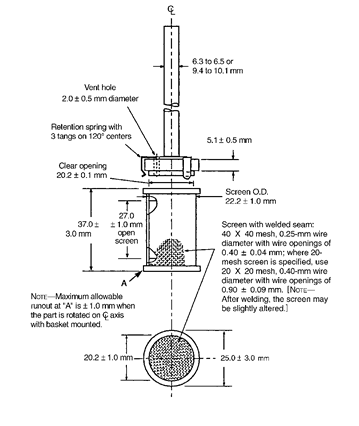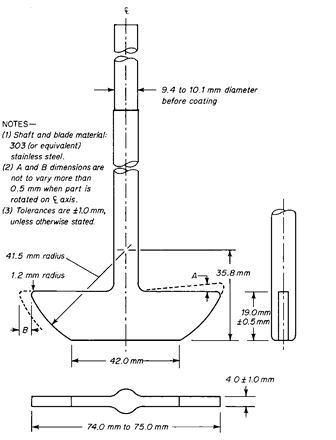á711ñDISSOLUTION
This test is provided to determine compliance with the dissolution requirements where stated in the individual monograph for a tablet or capsule dosage form.Of the types of apparatus described herein,use the one specified in the individual monograph.Where the label states that an article is enteric-coated,and a dissolution or disintegration test that does not specifically state that it is to be applied to enteric-coated articles is included in the individual monograph,the test for Delayed-Release Articlesunder Drug Release á724ñis applied unless otherwise specified in the individual monograph.For hard or soft gelatin capsules and gelatin-coated tablets that do not conform to the Dissolutionspecification,repeat the test as follows.Where water or a medium with a pHof less than 6.8is specified as the Mediumin the individual monograph,the same Mediumspecified may be used with the addition of purified pepsin that results in an activity of 750,000Units or less per 1000mL.For media with a pHof 6.8or greater,pancreatin can be added to produce not more than 1750USP Units of protease activity per 1000mL.
USP Reference Standards á11ñ— USP Prednisone Tablets RS(Dissolution Calibrator,Disintegrating).USP Salicylic Acid Tablets RS(Dissolution Calibrator,Nondisintegrating).
Apparatus 1— The assembly consists of the following:a covered vessel made of glass or other inert,transparent material1;a motor;a metallic drive shaft;and a cylindrical basket.The vessel is partially immersed in a suitable water bath of any convenient size or placed in a heating jacket.The water bath or heating jacket permits holding the temperature inside the vessel at 37±0.5
Shaft and basket components of the stirring element are fabricated of stainless steel,type 316or equivalent,to the specifications shown in Figure 1.
Unless otherwise specified in the individual monograph,use 40-mesh cloth.Abasket having a gold coating 0.0001inch (2.5µm)thick may be used.The dosage unit is placed in a dry basket at the beginning of each test.The distance between the inside bottom of the vessel and the basket is maintained at 25±2mm during the test.
Apparatus 2— Use the assembly from Apparatus 1,except that a paddle formed from a blade and a shaft is used as the stirring element.The shaft is positioned so that its axis is not more than 2mm at any point from the vertical axis of the vessel and rotates smoothly without significant wobble.The vertical center line of the blade passes through the axis of the shaft so that the bottom of the blade is flush with the bottom of the shaft.The paddle conforms to the specifications shown in Figure 2. The distance of 25±2mm between the blade and the inside bottom of the vessel is maintained during the test.The metallic or suitably inert,rigid blade and shaft comprise a single entity.Asuitable two-part detachable design may be used provided the assembly remains firmly engaged during the test.The paddle blade and shaft may be coated with a suitable inert coating.The dosage unit is allowed to sink to the bottom of the vessel before rotation of the blade is started.Asmall,loose piece of nonreactive material such as not more than a few turns of wire helix may be attached to dosage units that would otherwise float.Other validated sinker devices may be used.
Apparatus Suitability Test— Individually test 1tablet of the USP Dissolution Calibrator,Disintegrating Typeand 1tablet of USP Dissolution Calibrator,Nondisintegrating Type,according to the operating conditions specified.The apparatus is suitable if the results obtained are within the acceptable range stated in the certificate for that calibrator in the apparatus tested.
Dissolution Medium— Use the solvent specified in the individual monograph.If the Dissolution Mediumis a buffered solution,adjust the solution so that its pHis within 0.05unit of the pHspecified in the individual monograph.[NOTE—Dissolved gases can cause bubbles to form,which may change the results of the test.In such cases,dissolved gases should be removed prior to testing.3]
Time— Where a single time specification is given,the test may be concluded in a shorter period if the requirement for minimum amount dissolved is met.If two or more times are specified,specimens are to be withdrawn only at the stated times,within a tolerance of ±2%.
Procedure for Capsules,Uncoated Tablets,and Plain Coated Tablets— Place the stated volume of the Dissolution Medium(±1%)in the vessel of the apparatus specified in the individual monograph,assemble the apparatus,equilibrate the Dissolution Mediumto 37±0.5
If automated equipment is used for sampling and the apparatus is modified,validation of the modified apparatus is needed to show that there is no change in the agitation characteristics of the test.
Where capsule shells interfere with the analysis,remove the contents of not fewer than 6capsules as completely as possible,and dissolve the empty capsule shells in the specified volume of Dissolution Medium.Perform the analysis as directed in the individual monograph.Make any necessary correction.Correction factors greater than 25%of the labeled content are unacceptable.
Procedure for a Pooled Sample for Capsules,Uncoated Tablets,and Plain Coated Tablets— Use this procedure where Procedure for a Pooled Sampleis specified in the individual monograph.Proceed as directed under Procedure for Capsules,Uncoated Tablets,and Plain Coated Tablets.Combine equal volumes of the filtered solutions of the six or twelve individual specimens withdrawn,and use the pooled sample as the test solution.Determine the average amount of the active ingredient dissolved in the pooled sample.
Interpretation—
Unit Sample—
Unless otherwise specified in the individual monograph,the requirements are met if the quantities of active ingredient dissolved from the units tested conform to the accompanying Acceptance Table.Continue testing through the three stages unless the results conform at either S1or S2.The quantity,Q,is the amount of dissolved active ingredient specified in the individual monograph,expressed as a percentage of the labeled content;the 5%,15%,and 25%values in the Acceptance Tableare percentages of the labeled content so that these values and Qare in the same terms.
Acceptance Table
| Stage | Number Tested | Acceptance Criteria |
| S1 | 6 | Each unit is not less than Q+5%. |
| S2 | 6 | Average of 12units (S1+S2)is equal to or greater than Q,and no unit is less than Q-15%. |
| S3 | 12 | Average of 24units (S1+S2+S3)is equal to or greater than Q,not more than 2units are less than Q-15%,and no unit is less than Q-25%. |
Pooled Sample—
Unless otherwise specified in the individual monograph,the requirements are met if the quantities of active ingredient dissolved from the pooled sample conform to the accompanying Acceptance Table for a Pooled Sample.Continue testing through the three stages unless the results conform at either S1or S2.The quantity,Q,is the amount of dissolved active ingredient specified in the individual monograph,expressed as a percentage of the labeled content.
Acceptance Table for a Pooled Sample
| Stage | Number Tested | Acceptance Criteria |
| S1 | 6 | Average amount dissolved is not less than Q+10%. |
| S2 | 6 | Average amount dissolved (S1+S2)is equal to or greater than Q+5%. |
| S3 | 12 | Average amount dissolved (S1+S2+S3)is equal to or greater than Q. |
1
The materials should not sorb,react,or interfere with the specimen being tested.
2
If a cover is used,it provides sufficient openings to allow ready insertion of the thermometer and withdrawal of specimens.
3
One method of deaeration is as follows:Heat the medium,while stirring gently,to about 41 ,immediately filter under vacuum using a filter having a porosity of 0.45µm or less,with vigorous stirring,and continue stirring under vacuum for about 5minutes.Other validated deaeration techniques for removal of dissolved gases may be used.
,immediately filter under vacuum using a filter having a porosity of 0.45µm or less,with vigorous stirring,and continue stirring under vacuum for about 5minutes.Other validated deaeration techniques for removal of dissolved gases may be used.
4
If test specimens are filtered,use an inert filter that does not cause adsorption of the active ingredient or contain extractable substances that would interfere with the analysis.

